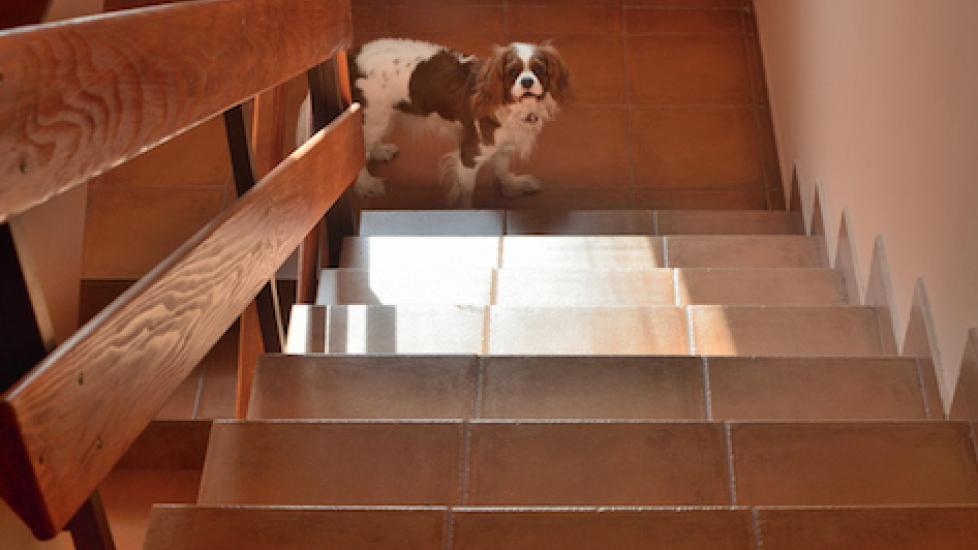5 Stair Safety Tips for Dogs
By John Gilpatrick
It’s hard to find a house without stairs. Whether you have a large split-level home or a simple one-story ranch with a porch, if you’re a dog owner, you hold your breath for a second whenever your pup bounds up or down the steps. And for good reason.
“Stair-related injuries can range from muscle strains and bruises to fractures, head injuries, and even death,” says Dr. Courtney Arnoldy, founder of the Small Animal Rehabilitation Program at University of Wisconsin Veterinary Care.
Luckily, many dogs are naturally equipped to ascend and descend a staircase, according to Dr. Jonathan Wood, staff clinician in neurology at the University of Pennsylvania School of Veterinary Medicine. “Most animals learn early on how to navigate stairs,” he says. “They have a drive to do so and a willingness to learn because they want to follow around their mother or their owner, and they have a natural cautiousness around edges that keeps them pretty safe.”
Puppies, older dogs, and breeds with long spines (like Dachshunds, Basset Hounds, and Corgis) tend to have trouble around stairs, Arnoldy says. It’s important for owners to do what they can to set up their canine companions for success.
Here are five stair safety tips for dogs that every pet parent should know and follow.
Supervise Your Dog
Simply watching your dog go up and down the stairs won’t prevent an accident, but it will keep them safe from other potential health problems or conditions that could be even more serious.
Wood says he uses stairs as a tool to diagnose various problems. “Owners tend to blame stairs for a dog’s inability or difficulty in getting around,” he says, “but usually, whatever is afflicting them is only making itself apparent when the dog uses the stairs.”
Dogs with orthopedic problems—including hips, knees, and hind legs—will have no trouble going down stairs but will show reluctance, struggle, or bunny hop their way back up, Wood says. When the reverse is true—no problem ascending, but showing unwillingness or pain while descending—the issue is usually with the dog’s elbows or shoulders.
Neurological issues look a little different. “Dogs with spine, neck, disc, and back problems find it painful to lift or lower their head when they go up or down stairs,” Wood says. “They might also struggle on stairs if they have vestibular disease, which affects balance. You might notice this if your dog hugs the wall while on stairs. They use it as support to help steady themselves.”
Simply watching your dog on the stairs will help you catch any of these problems—hopefully before a fall or before they become too serious. If you notice any of these scenarios, make an appointment with your vet as soon as possible.
Improve Visibility
Assuming your dog is using the stairs normally and you simply want to help prevent falls and other issues, better lighting is an extremely simple way to improve visibility and let your dog’s natural cautiousness kick in.
“Dark areas can be a safety risk for all dogs, especially those with poor eyesight, challenges with depth perception, weakness, balance challenges, or limited mobility,” Arnoldy says.
Install Stair Runners
While hardwood floors are an increasingly popular home design choice, Arnoldy says carpeted stairs or runners will provide good footing and reduce the risk of your dog slipping.
Those without carpeting can try putting grips on their dog’s toes, Wood adds. “They look like little rubber bands that go over the toenail and provide traction,” he says. “Most dogs won’t wear boots or shoes. A toe grip is a happy medium that they usually tolerate.”
Install Ramps
While dog ramps aren’t practical for long flights of stairs, they might be useful if you have a couple of steps up to your porch or between rooms. Arnoldy says a non-slip ramp could be a good alternative for dogs who simply can’t do stairs anymore.
If you pursue this option, you may need to train your dog so he navigates the ramp with care and confidence, Arnoldy adds. “Promote a slow pace by using positive reinforcement and a leash, harness, or sling,” she says, “and only use a ramp as tolerated.”
Carry Your Dog
Smaller dogs who can’t make it up steps, dogs who recently had surgery, or dogs who are on medications with sedative effects can be carried, so long as it’s safe for both the dog and the owner.
For bigger dogs who can’t be carried up and down repeatedly, it’s best to avoid the stairs when possible. Make sure everything your dog needs and enjoys is located on the main floor of your house. Block off the stairs when you’re not home or when you will be on a different floor than the dog for an extended period. When necessary, an appropriately placed sling or long towel (either under the belly or chest) can be used to help guide a larger dog, but only as directed by a veterinarian.
